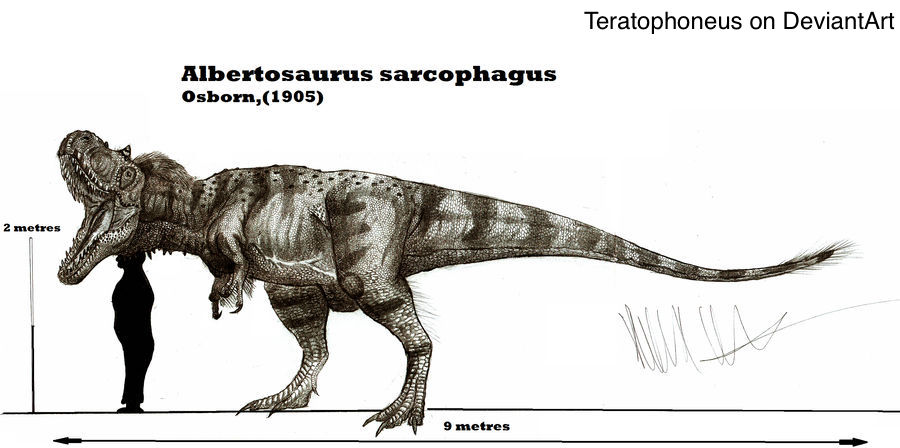Welcome to Albertosaurus

Name Definition
Alberta's lizard
Name Given By
Henry F. Osborn in 1905
Location
Horseshoe Canyon Formation alongside the Red Deer River in Alberta, Canada
Classification
Dinosauria, Saurischia, Theropoda, Tetanurae, Coelurosauria, Tyrannosauroidea, Tyrannosauridae, Albertosaurinae
Size
3 - 4 meters tall, 8 - 10 meters long, 1.3 - 4 tons
Temporal Range
Maastrichtian stage of the late Cretaceous, approximately 71 - 68 million years ago
Ecological niche
apex predator
Species/Sub Species
A. sarcophagus
Diet
Albertosaurus lived alongside many ornithopods and ceratopsians that it probably hunted as well as ornithomimosaurs ; ankylosaurs would been occasional as they were more defensive than other herbivores
Introduction
Albertosaurus is a genus of tyrannosaurid theropods that lived in Alberta during the late Cretaceous. Albertosaurus means “Alberta’s lizard” since it is from Alberta, while the species name sarcophagus means “flesh-eating” which coincidentally is the same name as the funeral container which are usually associated with ancient civilizations like Egypt and Rome. Albertosaurus was first discovered in 1884 in the Horseshoe Canyon Formation which obviously was the holotype that consisted of a small skull and some postcranial elements. However, these were not identified as Albertosaurus remains at first, and actually, before 1905, Albertosaurus was given another name by Edward D. Cope in 1892 called Laelaps incrassatus which he officially named earlier in 1866. However, the problem was Laelaps was a genus name already given to a mite, however, at the time there was another theropod named Dryptosaurus that was also given the name Laelaps, so when Othniel Charles Marsh knew this, he changed this theropod’s name to Dryptosaurus. If you know of Marsh and Cope, then you probably knew their rivalry and the so called “Bone Wars” which was a competitive fossil hunt to discover as many new genera of dinosaurs as possible. Because it was a fierce competition, Cope ignored this change to the genus name, so it was up to Lawrence Lambe to officially rename Laelaps incrassatus to Dryptosaurus incrassatus. However, this was not the end of the dispute, as Henry Osborn objected to this renaming for two key reasons. First, the description for Dryptosaurus incrassatus was based only on tyrannosaur teeth and there was no other skeletal remains to reveal any hidden autapomorphies, making an accurate comparison impossible without other remains. The second reason was because the dentition was different enough from the type species, Dryptosaurus aquilunguis, so it was different enough to be considered a new genus. After all this confusion, Osborn finally renamed the entire Laelaps genus to Albertosaurus in 1905. While it is less confusing today, Albertosaurus is often being mixed up with the other albertosaurine Gorgosaurus libratus. Both of them seem to have a lighter build than the rest of the tyrannosaurids. While this is true, some scientists still argue that there are enough morphological differences to consider them two different dinosaurs. This debate is still being continued and probably will not be concluded unless new fossil material with evidence reveals itself. Similar to Tyrannosaurus, Albertosaurus possessed a total of 58 banana-shaped teeth in its meter long skull. Unlike most other theropods, tyrannosaurids like Albertosaurus had heterodont dentition, and this claim is supported by the premaxillary teeth on the tip of the snout being smaller than the rest of the teeth and were also more tightly packed. However, due to its light build, it wasn’t able to produce as strong of a bite force as some other tyrannosaurids and only reached up to 3413 Newtons, though of course they were still capable of slicing or shearing meat. Albertosaurus also possessed bony ridges above its eyes which may have supported colorful crests in the males to display courtship to mates. There is some evidence to suggest that Albertosaurus was a social theropod, meaning it probably was a pack hunter. Barnum Brown discovered a bone bed in 1910 that contained tyrannosaur material. He didn’t have the time to excavate enough material from the bone bed, so he took what he could, and the bonebed wasn’t revisited until in 1997 when a team led by Philip J. Currie rediscovered the Dry Island bonebed. Now because the bonebed has been excavated properly, there are enough remains to identify 22 individuals of different ages and sizes. While this is the biggest concentration of Cretaceous theropods and second to Allosaurus concentration in the Cleveland Lloyd Dinosaur Quarry in Utah, some scientists aren’t convinced that this is evidence of social behavior and instead suggest that they were grouped together due to ecological factors such as flooding. Another suggestion is that they held some kind of competition and may have killed their own kind and cannibalized for feeding rights. Still, there is some modern-day evidence to object these claims, as pack hunting animals only form a group of one species with individuals of different ages. Anyways, even if it wasn’t a pack hunter, because of the different aged individuals discovered in the same bonebed, it has allowed scientists to research more about tyrannosaur growth, and Albertosaurus is now in fact one of the best known tyrannosaurs. Basically, how this growth happens is that it would have grown normally for its first few years in life before entering a growth spurt until it reaches sexual maturity. After being fully mature, Albertosaurus’ growth rate would have slowed down significantly and would continue growing until it reached maximum size or died before reaching maximum age. To add to this growth theory, it is also possible that the physical stresses caused by the rapid rate of growth would have made the less healthy tyrannosaurs more susceptible to diseases, which could explain how most of the adult Albertosaurus individuals did not reach the maximum potential size, and the biggest ever recorded was 10 meters in length while most of the other adults were only 9 meters in length. To conclude this, Albertosaurus is one of the more well-known tyrannosaurids not just in the scientific community, but its anatomy and growth is also more well-known due to the significant amount of remains discovered.